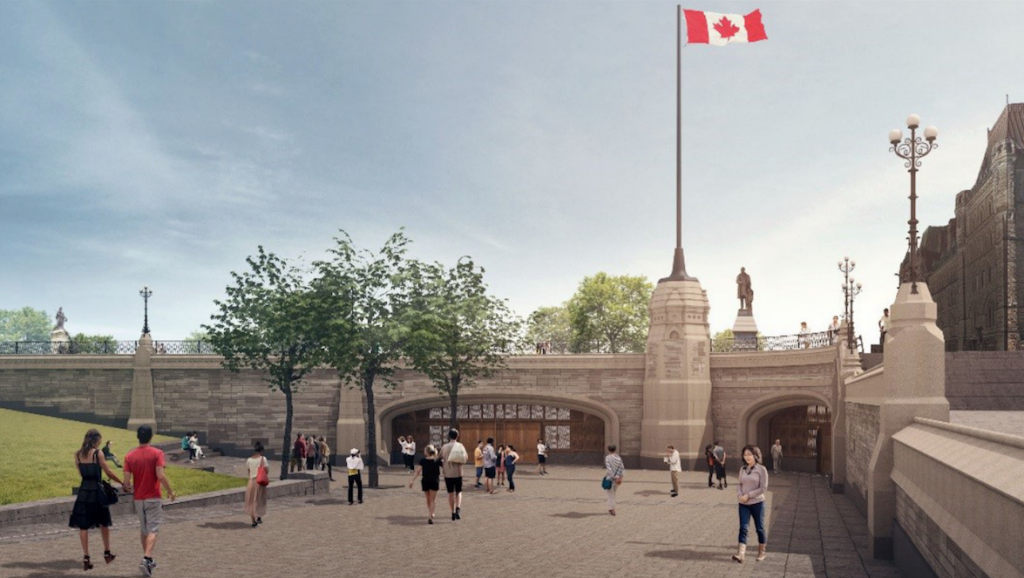David Johnston lays ceremonial cornerstone at Parliament Hill Welcome Centre
By Patrick Barrios
In late September, as one of his last acts as Governor General, former vice-regal representative David Johnston laid a ceremonial cornerstone for the Parliament Hill Welcome Centre, the first new building to be constructed on the Hill in more than a century.
The cornerstone bears the first inscription on Parliament Hill to be carved in both official languages, according to a statement from Public Services and Procurement Canada, in tribute to what the department describes as Johnston’s “passion for both linguistic duality and education.”
But the Welcome Centre — set to open in time for next year’s fall parliamentary session — will not be an imposing addition to Ottawa’s skyline. Designed as a four-level underground complex, visitors will enter through a subtle main entrance on the west side of Centre Block.

Willowbank graduate Justine Southam carves inscription on the new Welcome Centre cornerstone. Michael Lewis, Public Services and Procurement Canada
This entrance to the building, which will serve as the main portal to Parliament for tourists, will be flanked by the new cornerstone, a 1,000-kilogram block of limestone hailing from the Niagara-area town of Queenston, Ont., a rural community with a population of about 300.
Its ceremonial placement on Sept. 28 was attended by Johnston, Prime Minister Justin Trudeau, and reprsentatives of Willowbank, the Queenston, Ont.-based heritage conservation group and school that spearheaded the cornerstone project in association with the federal government.
“There’s tremendous pride, even in a village as small as Queenston, in contributing its artisans, craftsmen, and materials to the historic fabric of our country,” said Willowbank executive director Janis Barlow.

The new Welcome Centre cornerstone’s inscription was carved by Danny Barber, a Willowbank faculty member whose workshop is in Ottawa. It took the Niagara-area native and his assistant, Willowbank graduate Justine Southam, 65 hours to carve it.
The inscription includes 200 letters, each measuring just under one inch – or about 2.5 centimetres – in height.
“The letters were a carvable size, but with such a hard stone, their height meant there were some very narrow bars or portions of the letters,” said Barber, who carved the inscription using only hammers and mallets. “Also, the surface is … very smooth, and that makes the stone more brittle. I had to be very careful.”
The cornerstone-laying tradition hearkens back to Canada’s foundations in 1860, when an 18-year old Prince Albert Edward (later King Edward VII) laid a white-limestone cornerstone for Canada’s original Parliament Buildings.
After Parliament’s Centre Block burned to the ground in February 1916, the durable cornerstone was recovered unscathed from the ashes. Prince Edward’s brother, Prince Arthur, was Governor General at the time, and he relaid the stone in September 1916 at the outset of the new Centre Block’s construction.
A third cornerstone-laying ceremony was held in 1919, during the construction of the Peace Tower.
The material from which the new cornerstone was made is also brimming with meaning.
Queenston limestone comes from the Queenston Quarry, in Niagara-on-the-Lake (formerly Newark), which was the first capital of Upper Canada from 1792 to 1796. The same strand of limestone is deeply entrenched in Ottawa’s architectural fabric, from the walls of the Sir John A. Macdonald Building on Wellington Street to the external staircase leading to Parliament’s West Block.
Despite its significance in Canadian architectural history, Queenston Quarry has seen some tough times, said Nigel Molaro, a member of Willowbank’s board of directors and the person who initially conceptualized the cornerstone project.
“The Queenston Quarry saw a decline in use in the late 20th century, and recently reopened and found a new purpose in the conservation of existing buildings that use Queenston limestone,” said Molaro.
In fact, the renewal of Canadian heritage sites is reviving interest in stone carving and stone masonry throughout the country.
“There’s demand to maintain the historic fabric that we have, and to make sure that we create, with solidarity to the past, the structures of the future,” explained Barlow.
In a statement, PSPC praised Willowbank’s efforts to revive stone masonry in Canada, saying that the organisation’s “unique diploma programs in heritage conservation are helping ensure future generations have the skills to continue important work on our most important buildings.”

